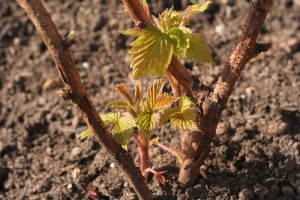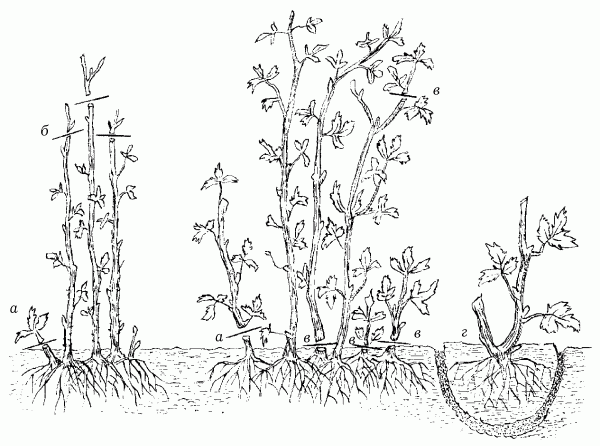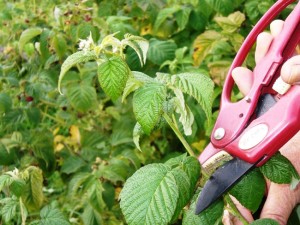Annual spring pruning of raspberries is the key to a good harvest
Many amateur gardeners do not give up the importance of pruning raspberries in the spring, believing that the amount of harvest is directly proportional to the size of the bush. However, it is impossible to get a large harvest with large berries from an unkempt and overgrown raspberry tree. In addition, a bush that is regularly pruned will bear fruit much longer in one place.
Pruning raspberries in the spring is an important and necessary part of caring for a raspberry plant and a guarantee of its good and regular fruiting. Raspberry shoots live, as a rule, only two years: in the first, they actively grow and branch, and in the second, they bear fruit and die off. In addition, unkempt bushes are susceptible to many diseases, pests, berries become smaller in a short time, and the yield is sharply reduced. Most gardeners consider spring to be the best time for pruning.

Content
Pruning time
In early spring, when the snow melts, but the earth has not yet had time to warm up and a positive air temperature is established, normalization of all plant shoots is carried out. Depending on the climatic conditions of a particular region, pruning times can range from early March to April or May. For example, in Ukraine, in particular in the southeast, pruning should not be carried out earlier than mid-April, but in the southern regions it can be carried out in the first days of March.
As a rule, together with spring pruning, summer pruning is also carried out, since the matured stems dry out by mid-August. It is better to remove them immediately after harvest. In this case, the lighting conditions for the replacement shoots will improve, and most of the plant's nutrients and forces will go to them. It also stimulates the growth of underground offspring. If too much young growth has formed, it is removed, leaving 6-10 offspring per bush.

Raspberry pruning scheme in spring
What is double cropping?
Several decades ago, A.G. Sobolev, the patriarch of malpberry farming. developed a simple but very effective way to double prune raspberries. According to the Sobolevsky method, the first pruning is carried out in the last weeks of May - early June. You should not prune raspberries in the spring after mid-June, as the side shoots will not have time to develop enough to withstand the winter frosts. If this time was missed, for any reason, it is better to postpone it to the next year or spend it in the fall. When young shoots reach 75-100 cm in height, depending on the height of the variety, they pinch the top by 12-20 cm.After that, further upward growth practically stops, and lateral shoots begin to develop intensively. A few days later, the first shoots appear in the axils of the upper leaves, and by August 5-8 well-developed lateral shoots are formed, up to 45-55 cm in length. In this form, the bush is left to winter.

The next year, a second pruning is carried out. In the spring, when several leaves appear on the bushes, the tops of the overwintered lateral shoots are shortened by 6-17 cm. After that, the bush develops intensively, dormant buds wake up and new branches appear. And already by the beginning of fruiting, more than 10-15 developed shoots are formed.
It is the second pruning that is decisive in this method. After such manipulation in spring, even simple raspberries become more productive and can acquire remontant properties.
With good care, especially in curly raspberries, double pruning can be done in one season.In this case, the first time the shoot is pinched when it stretches 25-45 cm, and the second time - when the side shoots are of the same length. However, one should take into account and be prepared for the disadvantages of this method. For example, it provokes excessive thickening of the plantings, and a good result will be only with proper planting, preliminary care and regular application of all the necessary fertilizers.

Pruning technique
At the first spring normalization, all frozen branches, weak, underdeveloped, broken shoots are removed, cutting them off at the very base of the bush, which will reduce the risk of infection of raspberries with various diseases. Several strong branches are left on the bush, depending on the planting method - if the raspberries are planted in a bush method, then no more than 4-6 are left per bush, if trenched - 13-16 per 1 m of the row. Their number can fluctuate per 1 sq. M in the range from 13 to 18, at a distance of 20-25 cm from each other. Together with the normalization of the branches, the frozen tops of the plant are cut off, shortening them to the first healthy bud, but not excessively, by no more than 22-25 cm. Strong shortening of plant stems, although it increases the size of the berries and their number on the branches, however, in general, reduces the yield ...
The branches prepared in this way are tied to an established trellis or support, like grapes. To fully provide the productive main shoots with food, it is necessary to cut down or dig up, using as planting material, all the young growth outside the planting, which can greatly deplete the raspberry tree. To avoid damage to the root system, excess shoots should not be abruptly pulled out of the soil or dug out unnecessarily, you can limit yourself to a simple pruning under the root with a pruner or at a depth with a shovel immediately after germination. To cut down the shoots correctly, you should stick a sharply sharpened shovel into the ground in a circle several times at a distance of 18-25 cm from the main bush. Then the earth is dug outside the circle. Thus, each bush in the raspberry bush is processed, while the distance between them should be at least 55-65 cm.

The annual stems of the plant, left for fruiting, are shortened by 15-40 cm. With this shortening, only the immature top with underdeveloped buds is removed, from which only weakened fruiting shoots with small berries can develop. On vines that have been pruned, fruiting is more complete, and the ripening of berries is simultaneous. If diseased, damaged shoots are found after spring normalization, their removal should not be postponed until autumn, since they are a threat to the disease for the entire raspberry tree.
If you regularly cut young raspberries, the whole procedure will not take much time, you can keep within 5-10 minutes. After each pruning, it is advisable to carry out a disinfecting spraying of the bushes with special preparations, and take all the trimmed branches and shoots outside the raspberry tree and burn them.
Video "Spring pruning of raspberries - the key to a good harvest"
This video tells when it is better to prune, it shows what annual shoots look like, to what maximum size they are pruned, and reveals many nuances of spring raspberry pruning.
